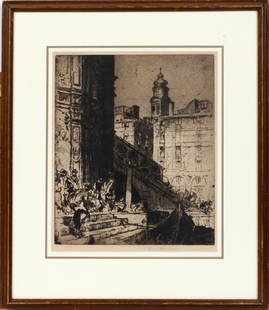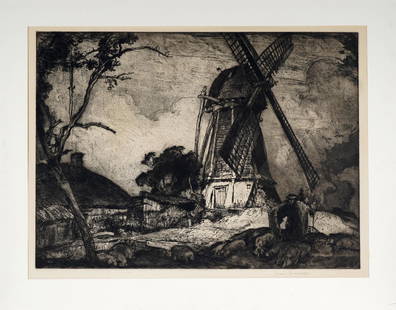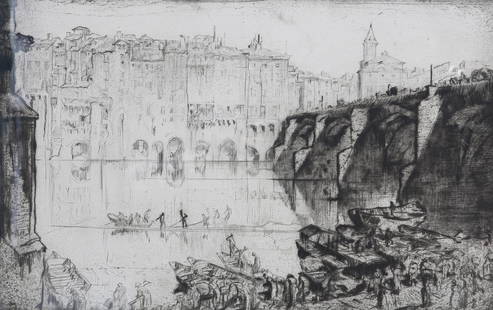
FRANK BRANGWYN 1867-1956 Study for "British Emp
Similar Sale History
View More Items in CollectiblesRelated Collectibles
More Items in Collectibles
View More


Item Details
Description
FRANKBRANGWYN1867-1956Study for "British Empire Panels", The Guildhall, Swamsea, 1925Unique gelatin silver print.6 ½ x 4 ½ in. (16.5 x 11.4 cm).Literature
Cava, Frank Brangwyn: Photographs, Nude and Figure Studies, pl. 6There isn't much sense in overhyping the small but extremely potent body of surviving photographs by Frank Brangwyn, painter, muralist, graphic artist and designer. In scale, in quantity and intent, his camera output was inconsequential compared to the distinguished number of his canvases and well known public works, or to the grandiose degree of their execution. Instead, we are left to ponder a remarkable and stunning group of figure studies and nudes whose original and naïve objective seems secondary to how we perceive them today. If it wasn't known these were sketches done as a painter's aid, simple steps towards a more serious result, it would be tempting to believe this cache of images were conceived for private reasons, not public results; that they were intimate and not incidental.
Most genuinely good photographs benefit from time passing, like wine of equal quality – and perhaps that's why the appropriated enological term "vintage" often seems reasonable. Photographs benefit with distance from the time of their creation and from contexts rendered by other, simultaneously produced works. When their original purpose fades and, like chimera dissolves into air, the bare artifact is redefined by the eyes of another era. In Brangwyn's case, do we really care that he was, for a period, among the most celebrated artists of his time, and so popular he's a precursor to the art stars of the past fifty years? Does it matter that these naturalist representations in silver and platinum, with their scored and marked grids intended for copying and enlarging onto canvas were merely visual references, created from reality for their maker? Or, is it more important to recognize the irony that while photographic "artists" were doing their damndest to create images which vied for the same heartstrings their painterly predecessors plucked, it took an artist who didn't give a damn about photography as "Art" to create genre studies infused with enough reality to entice the senses with the light and nimble limbs of children, the musculature of working men or the loving embrace of a naked mother with her child?
There has been a resurgence of interest in Frank Brangwyn recently. To commemorate the fiftieth anniversary of his passing in 1956, a retrospective organized by the Leeds City Art Gallery and the Musea Brugge is traveling until early 2007. Forgotten in the pursuant years since his heyday, the exhibition reestablishes Brangwyn's international reputation by reintroducing him to an otherwise unaware audience. The salient points of Brangwyn's life reveal a man whose work ethic was undaunted either by shifting tastes or by age. Born in 1867 in Bruges, Belgium, he was raised in England and self-taught as a painter, apprenticed in his father's workshop and for a short time, studied with William Morris. He was talented working on any scale, from easel painting to murals, book illustrations to posters. He designed architecture, interiors, stained glass, furniture, carpets, ceramics and jewelry. With an affinity for the Arts and Crafts movement he worked equally in earnest within the mode of Art Deco. His murals hang in St. Aidan's Church, Leeds; the Skinner's Hall, London; Guildhall, Swansea; and Rockefeller Center, New York. It is estimated that he produced over 12,000 works during his lifetime.
Brangwyn's use of photography may have been twofold: the obvious use as figure studies for the murals and perhaps as a sensual aside from his more exalted civic reputation. In her biography of Brangwyn outlined in the exhibition catalogue accompanying the retrospective, Frank Brangwyn, 1867-1956, Libby Horner postulates, "Surprisingly, some of the most exquisite photographs Brangwyn took are of nude or partially dressed women, revealing a frisson of sensuality which is entirely lost in the completed oils and murals. In fact women appear infrequently in the artist's work: of the seventy-six figures in the mosaic at St. Aidan's only eight are female. Brangwyn strove for a sublimation of the sensual, a rigorous toning down of the erotic curve into a presence which is purely decorative, a painting where 'the woman's backside… is no more important than the melon or the goat, and then it is part of a grand design'. Perhaps unfortunately, Brangwyn succeeded too well: his later female forms appear like manikins, soul-less, frigid and without individuality" (op. cit., p. 44). Many of the photographs offered here relate directly to figures in particular commissions and are so noted in their descriptions. All but one photograph offered here, and in lots 67 to 75, is believed to be unique as no other copies have been uncovered to date. According to Horner, Brangwyn left behind a cache of about 1,000 photographs but the majority of those were travel and topographic works by others. His own work represents a fraction of that.
Brangwyn was not the first artist to use photography solely for study purposes. Some delighted in the process while others begrudgingly took it on as a necessary step in making art in modern times, nothing more than a record of their working process. The attitudes and approaches are as varied as the practitioners. Thomas Eakins was methodical, surgical and premeditated when it came to photography, knowing exactly what he sought. Degas was a hack as a photographer, perhaps recognizing that the means it took to operate a camera with the necessity of a monochromatic end would never match the dexterity of his hand or the brilliance of his eye. Picasso, a wizard with a pencil or brush was a jester with a camera. Brancusi, the sculptor, produced images of his own work with the same insistence of fact that his polished bronzes and marble abstractions claimed in space, demanding weight and strict vision of his subjects.
The ease which Brangwyn comfortably settled into making photographs however, the remarkable naturalness of his poses, his lighting, his exposures – not in the technical sense but as revelations – were as automatic as breathing and as committed as prayer. In the unforced and modest acceptance of the life before the lens he reminds us, not in style but in temperament, of Paul Strand or Emmet Gowin. For us, one hundred years later, his limited pursuit is unfortunate, leaving us yearning for more and asking, "Can this be all?" We are, as viewers, jilted lovers, not exactly unrequited but not fully satisfied either.
See lots 11-13 and 67 to 75 for other works by Brangwyn.
Cava, Frank Brangwyn: Photographs, Nude and Figure Studies, pl. 6There isn't much sense in overhyping the small but extremely potent body of surviving photographs by Frank Brangwyn, painter, muralist, graphic artist and designer. In scale, in quantity and intent, his camera output was inconsequential compared to the distinguished number of his canvases and well known public works, or to the grandiose degree of their execution. Instead, we are left to ponder a remarkable and stunning group of figure studies and nudes whose original and naïve objective seems secondary to how we perceive them today. If it wasn't known these were sketches done as a painter's aid, simple steps towards a more serious result, it would be tempting to believe this cache of images were conceived for private reasons, not public results; that they were intimate and not incidental.
Most genuinely good photographs benefit from time passing, like wine of equal quality – and perhaps that's why the appropriated enological term "vintage" often seems reasonable. Photographs benefit with distance from the time of their creation and from contexts rendered by other, simultaneously produced works. When their original purpose fades and, like chimera dissolves into air, the bare artifact is redefined by the eyes of another era. In Brangwyn's case, do we really care that he was, for a period, among the most celebrated artists of his time, and so popular he's a precursor to the art stars of the past fifty years? Does it matter that these naturalist representations in silver and platinum, with their scored and marked grids intended for copying and enlarging onto canvas were merely visual references, created from reality for their maker? Or, is it more important to recognize the irony that while photographic "artists" were doing their damndest to create images which vied for the same heartstrings their painterly predecessors plucked, it took an artist who didn't give a damn about photography as "Art" to create genre studies infused with enough reality to entice the senses with the light and nimble limbs of children, the musculature of working men or the loving embrace of a naked mother with her child?
There has been a resurgence of interest in Frank Brangwyn recently. To commemorate the fiftieth anniversary of his passing in 1956, a retrospective organized by the Leeds City Art Gallery and the Musea Brugge is traveling until early 2007. Forgotten in the pursuant years since his heyday, the exhibition reestablishes Brangwyn's international reputation by reintroducing him to an otherwise unaware audience. The salient points of Brangwyn's life reveal a man whose work ethic was undaunted either by shifting tastes or by age. Born in 1867 in Bruges, Belgium, he was raised in England and self-taught as a painter, apprenticed in his father's workshop and for a short time, studied with William Morris. He was talented working on any scale, from easel painting to murals, book illustrations to posters. He designed architecture, interiors, stained glass, furniture, carpets, ceramics and jewelry. With an affinity for the Arts and Crafts movement he worked equally in earnest within the mode of Art Deco. His murals hang in St. Aidan's Church, Leeds; the Skinner's Hall, London; Guildhall, Swansea; and Rockefeller Center, New York. It is estimated that he produced over 12,000 works during his lifetime.
Brangwyn's use of photography may have been twofold: the obvious use as figure studies for the murals and perhaps as a sensual aside from his more exalted civic reputation. In her biography of Brangwyn outlined in the exhibition catalogue accompanying the retrospective, Frank Brangwyn, 1867-1956, Libby Horner postulates, "Surprisingly, some of the most exquisite photographs Brangwyn took are of nude or partially dressed women, revealing a frisson of sensuality which is entirely lost in the completed oils and murals. In fact women appear infrequently in the artist's work: of the seventy-six figures in the mosaic at St. Aidan's only eight are female. Brangwyn strove for a sublimation of the sensual, a rigorous toning down of the erotic curve into a presence which is purely decorative, a painting where 'the woman's backside… is no more important than the melon or the goat, and then it is part of a grand design'. Perhaps unfortunately, Brangwyn succeeded too well: his later female forms appear like manikins, soul-less, frigid and without individuality" (op. cit., p. 44). Many of the photographs offered here relate directly to figures in particular commissions and are so noted in their descriptions. All but one photograph offered here, and in lots 67 to 75, is believed to be unique as no other copies have been uncovered to date. According to Horner, Brangwyn left behind a cache of about 1,000 photographs but the majority of those were travel and topographic works by others. His own work represents a fraction of that.
Brangwyn was not the first artist to use photography solely for study purposes. Some delighted in the process while others begrudgingly took it on as a necessary step in making art in modern times, nothing more than a record of their working process. The attitudes and approaches are as varied as the practitioners. Thomas Eakins was methodical, surgical and premeditated when it came to photography, knowing exactly what he sought. Degas was a hack as a photographer, perhaps recognizing that the means it took to operate a camera with the necessity of a monochromatic end would never match the dexterity of his hand or the brilliance of his eye. Picasso, a wizard with a pencil or brush was a jester with a camera. Brancusi, the sculptor, produced images of his own work with the same insistence of fact that his polished bronzes and marble abstractions claimed in space, demanding weight and strict vision of his subjects.
The ease which Brangwyn comfortably settled into making photographs however, the remarkable naturalness of his poses, his lighting, his exposures – not in the technical sense but as revelations – were as automatic as breathing and as committed as prayer. In the unforced and modest acceptance of the life before the lens he reminds us, not in style but in temperament, of Paul Strand or Emmet Gowin. For us, one hundred years later, his limited pursuit is unfortunate, leaving us yearning for more and asking, "Can this be all?" We are, as viewers, jilted lovers, not exactly unrequited but not fully satisfied either.
See lots 11-13 and 67 to 75 for other works by Brangwyn.
Buyer's Premium
- 22.5% up to $200,000.00
- 14.5% above $200,000.00
FRANK BRANGWYN 1867-1956 Study for "British Emp
Estimate $8,000 - $10,000
2 bidders are watching this item.
Shipping & Pickup Options
Item located in New York, NY, usSee Policy for Shipping
Payment

TOP




























































![George Washington Signed Discharge: Partly printed discharge document signed by George Washington, as Commander in Chief of the Armies of the United States. Newburgh, [New York], 4 January 1783. 1 page, ## x ## in. Undersigned by Washin](https://p1.liveauctioneers.com/7226/322253/173251475_1_x.jpg?height=310&quality=70&version=1710004847)
![[Ambrotype] Texas Confederate Soldier: Sixth plate ambrotype. Full leatherette case. Portrait of a possible Texas Confederate soldier. A silver star device was used to pin up the brim of his light-toned headgear, a look often seen in image](https://p1.liveauctioneers.com/7226/322253/173251509_1_x.jpg?height=310&quality=70&version=1710004847)




